Blakinston’s Fish Owl Profile
Found only in a few countries in Northeast Asia, the Blakiston’s fish owl is considered to be the largest living owl on earth.
These huge birds can weigh well over 4 kilograms and have a wingspan up to 2 metres. Blakiston’s fish owls stand at around 70cm in height, have bright yellow eyes and huge feet and claws.
They are mostly brown in colour with thinly barred chests, wings and tails.
Due to their massive size and majestic appearance, the Blakiston’s fish owl is often revered in the areas in which it inhabits and in Japanese culture they are respected as divine beings.
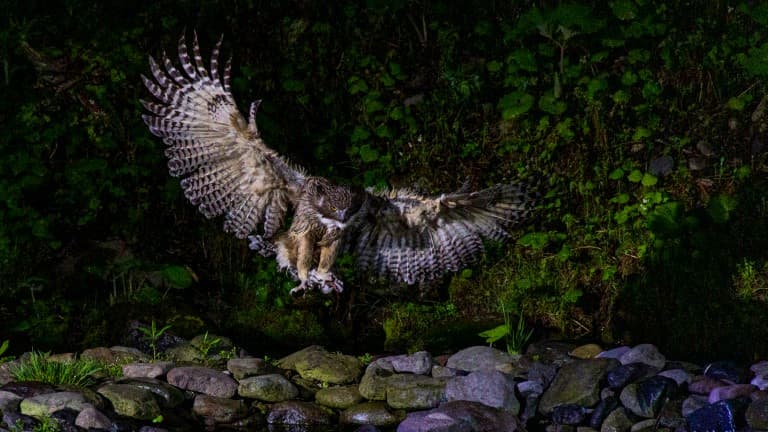
Blakinston’s Fish Owl Facts Overview
| Habitat: | Dense old-growth forest along rivers and lakes |
| Location: | Northeast Asia (China, Japan, Far East Russia) |
| Lifespan: | 20+ years in the wild |
| Size: | 60 – 70 cm in length, with a wingspan of up to 2m |
| Weight: | 3 – 4.6 kg |
| Color: | Very large owl, mostly light brown in colour with lighter chest feathers, black stripes on underside and yellow stripes on tail and wings. Bright yellow eyes and large ears tufts |
| Diet: | Mainly fish but occasionally eats amphibians, crustaceans and small mammals |
| Predators: | No natural predators, but chicks may be predated on by carnivorous mammals |
| Top Speed: | Not recorded, but these birds are swift and powerful fliers |
| No. of Species: | 1 |
| Conservation Status: | Endangered |
Blakiston’s fish owls require very specific types of habitat to survive and breed and thus have a very specific distribution across their range.
These owls show a clear preference for dense, forested areas, especially those with abundant old-growth forest. As their diet consists mainly of fish, they inhabit forest that is near or borders rivers and lakes, where their preferred food source is abundant.
Within these riparian forests, large, old trees are usually abundant and it is in the cavities of these, that the Blakiston’s fish owl nests.
Unlike most species of owl, the Blakiston’s fish owl survives on a diet of fish, occasionally supplementing this with amphibians, crustaceans and small to medium sized mammals.
Despite being the largest owl in the world, the Blakiston’s fish owl is still relatively unknown and until recently there have only been a handful of studies relating to these giant owls.
This is partly because they are found in remote regions with harsh winter conditions and because the Blakiston’s fish owl is mostly active at night. It is estimated there are fewer than 4,000 individuals of the species remaining as a result of habitat loss and habitat change. 1
They are currently classified as endangered by the IUCN. This owl also lives in areas where the Asiatic black bear and Amur tiger are found and protection of their habitat has been beneficial to all species living there. 2
Interesting Blakinston’s Fish Owl Facts
1. They are the largest owl on the planet
The Blakiston’s fish owl is heavier and has a larger wingspan than the Eurasian eagle on average, with females weighing over 4 kilograms and a wingspan up to 2 metres.
The Blakiston’s fish owl came 10th in our The Largest Flying Birds in The World piece. 3
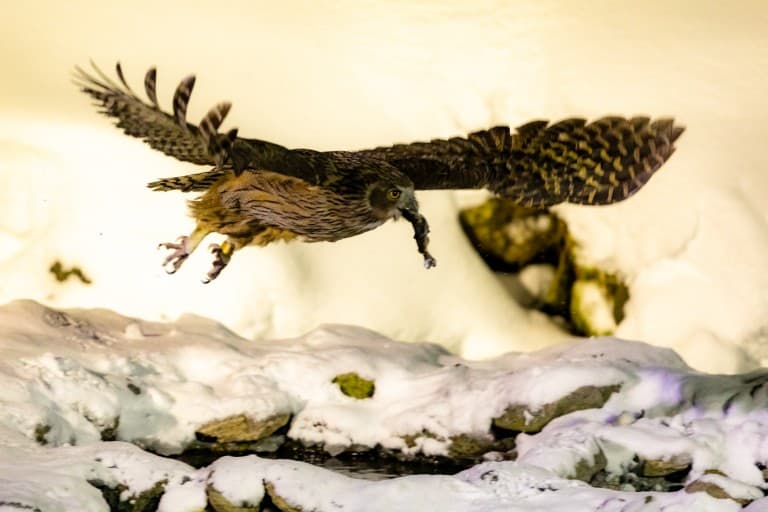
2. They are only found in Siberia, China and Japan
Blakiston’s fish owls live in remote habitats that often have very cold winters. 4
3. They have incredible senses adapted for hunting
As with most owls, the Blakiston’s fish owl has a facial disc of feathers that serves as a sound collector. This adaptation allows these fishing owls to hear even the most undetectable rustle in the grass or splash near the water surface.
As well as excellent hearing, they also have superb sight, giving them the ability to judge height, distance and speed of movement with ease. This is especially important during colder periods or when the owls have chicks, as they adjust their hunting strategy to taking different prey species or even hunting both at night and during the day.
4. Their diet consists mainly of fish
There are only around 6 species of owl in the world who feed almost entirely on fish.
They are superb when it comes to fishing, swooping down with great speed and using their large claws to grasp fish such as trout and salmon from the water. As well as fish, Blakiston’s fish owls will feed on frogs and crustaceans by wading in shallow water and flushing these animals out of the mud.
In most of their range, bodies of water often freeze in winter and during this time, they will catch and eat prey as large as hares, rabbits and waterfowl.
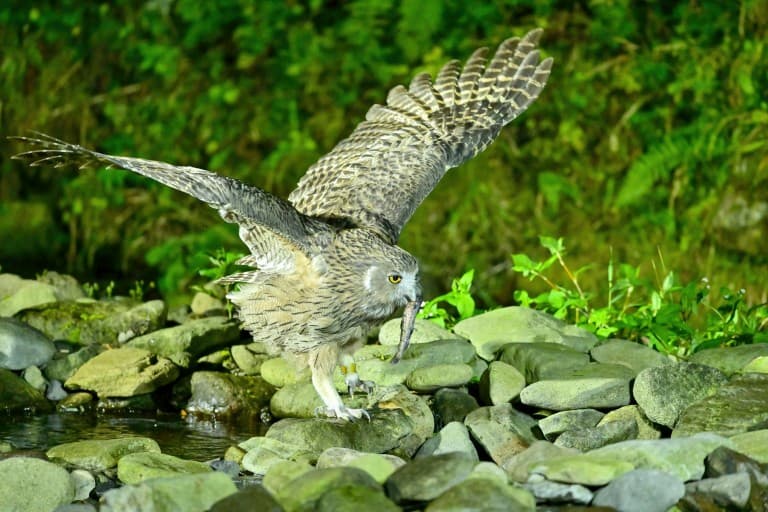
5. The Blakinston’s fish owl is rarely far from water
These owls live exclusively in forests near river or lakes, where most of their prey are found. 5
6. Their favourite prey are pike, salmon and trout
Blakiston’s fish owls tend to prefer more fatty fish which provide more energy when eaten.
Fish that weigh even more than the owl itself are sometimes dragged to the shore so the owl doesn’t have to lift it out the water.
7. They spend large amounts of time on the ground
Either wading in the water shallows or searching for rodents under the snow, Blakiston’s fish owls are very comfortable walking in search of food. 6
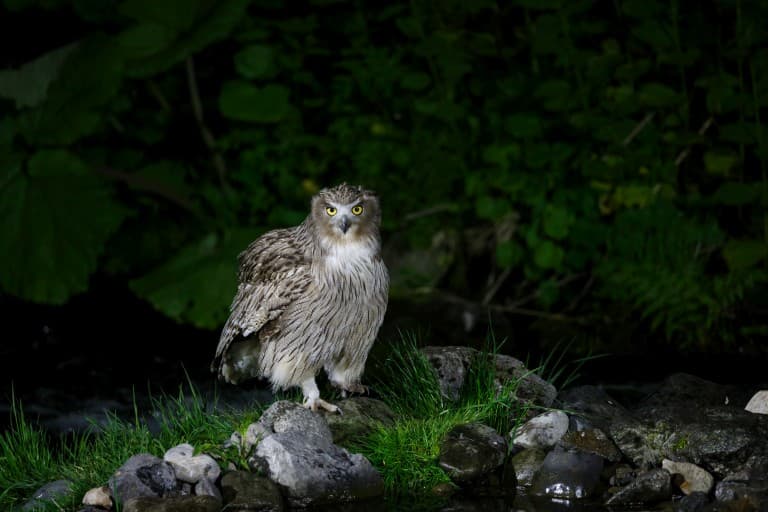
8. Blakiston’s fish owls can even nest on the ground
Due to their huge frames, Blakiston’s fish owls tend to nest only in the largest trees in their habitat. Their nests are often found at a great height, sometimes 20 metres above the ground.
Although they can build rudimentary nests from twigs and branches, Blakiston’s fish owls prefer to nest in the cavities situated on top of dead or old-growth trees. In areas where minimal ground dwelling predators are found, these owls have also been observed nesting in large, fallen logs on the forest floor.
9. They are incredibly patient hunters
When perched on a tree, scanning the water for fish, the Blakiston’s fish owl may sometimes wait several hours before grabbing its prey. 7
10. Blakiston’s fish owls sometimes catch prey heavier than themselves
During icy conditions, these owls may catch hares and rabbits that weigh as much or more than they do.
11. They are less silent than other owl species when hunting
As they mainly hunt fish, Blakiston’s fish owls lack the soft, feathered wing ridges that usually make owl flight more silent. 8
12. Males and females usually stay together for life
Young Blakiston’s fish owls live a mostly solitary life until they mature and find a mate.
Blakiston’s fish owls are monogamous and breeding pairs synchronise their calls so that they can communicate even when out of sight. 9
13. They are excellent parents
Blakiston’s fish owls are hugely attentive parents and both the male and female help raise the chicks until they are fully independent. These birds only breed once every 2 or 3 years, commonly producing only one or two eggs during this time.
Females incubate the eggs and the chicks hatch at the onset of spring, when food is most abundant. Both parents hunt for the chicks until they leave the nest at around 2 months of age. However even when the chicks are fully independent, the parents allow them to remain in the territory until the chick finds a mate of its own.
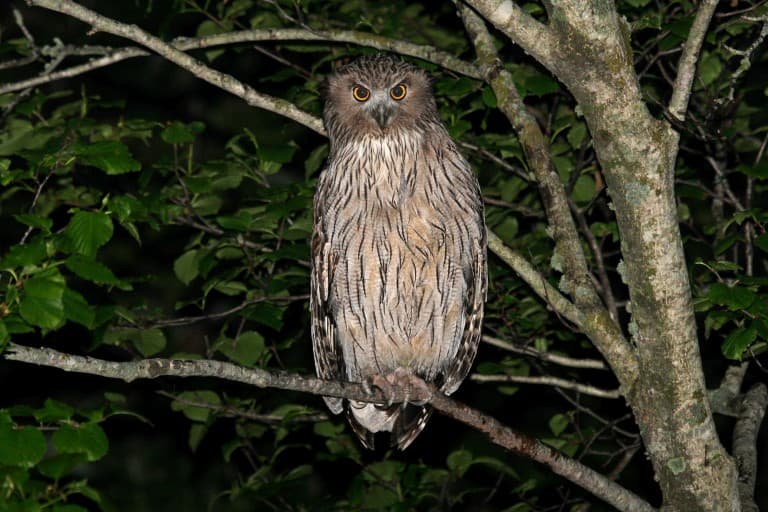
14. Blakinston’s fish owls mature slowly
They are relatively long-lived birds, surviving to over 20 years in the wild and breeding pairs that are undisturbed may stay together for life.
As their lifespan is quite long, these owls mature slowly and offspring sometimes remain in the area where they hatched for up to 18 months before becoming fully independent.
15. Areas where several Blakinston’s fish owls are found are usually in good ecological health
As they require clean rivers and undisturbed habitat, Blakiston’s fish owls are an indicator species and their presence indicates a healthy ecosystem and food chain.
Blakinston’s Fish Owl Fact-File Summary
Scientific Classification
| Kingdom: | Animalia |
| Phylum: | Chordata |
| Class: | Aves |
| Order: | Strigiformes |
| Family: | Strigidae |
| Genus: | Ketupa |
| Species Name: | Ketupa Blakistoni |
Fact Sources & References
- Emily Silber (2015), “How Loggers Can Help Save the Endangered Fish Owl”, Audubon.
- Jonathan C. Slaght (2015), “Blakiston’s Fish-owl Bubo blakistoni and logging: Applying resource selection information to endangered species conservation in Russia”, Cambridge University Press.
- “Blakistons Fish Owls”, Wildlife Ecology.
- Keita Omote (2015), “Recent fragmentation of the endangered Blakiston’s fish owl (Bubo blakistoni) population on Hokkaido Island, Northern Japan, Revealed by Mitochondrial DNA and Microsatellite Analyses”, NIH.
- John P. Rafferty (1998), “fish owl”, Britannica.
- “Blakiston’s Fish-Owl”, eBird.
- (2021), “Blakiston’s Fish-Owl”, Bird Note.
- Erik Oien, “Bubo blakistoni Blakiston’s eagle-owl”, Animal Diversity Web.
- Deane Lewis (2020), “Blakiston’s Fish Owl – Bubo blakistoni”, The Owl Pages.
